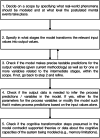A framework for building cognitive process models
- PMID: 32632887
- PMCID: PMC7704479
- DOI: 10.3758/s13423-020-01747-2
A framework for building cognitive process models
Abstract
The term process model is widely used, but rarely agreed upon. This paper proposes a framework for characterizing and building cognitive process models. Process models model not only inputs and outputs but also model the ongoing information transformations at a given level of abstraction. We argue that the following dimensions characterize process models: They have a scope that includes different levels of abstraction. They specify a hypothesized mental information transformation. They make predictions not only for the behavior of interest but also for processes. The models' predictions for the processes can be derived from the input, without reverse inference from the output data. Moreover, the presumed information transformation steps are not contradicting current knowledge of human cognitive capacities. Lastly, process models require a conceptual scope specifying levels of abstraction for the information entering the mind, the proposed mental events, and the behavior of interest. This framework can be used for refining models before testing them or after testing them empirically, and it does not rely on specific modeling paradigms. It can be a guideline for developing cognitive process models. Moreover, the framework can advance currently unresolved debates about which models belong to the category of process models.
Keywords: Cognitive model; Cognitive process model; Computational model; Definitions; Marr’s levels.
Figures



References
-
- Achinstein P. Theoretical models. The British Journal for the Philosophy of Science. 1965;XVI(62):102–120. doi: 10.1093/bjps/XVI.62.102. - DOI
-
- Anderson JR. Is human cognition adaptive? Behavioral and Brain Sciences. 1991;14(3):471–485. doi: 10.1017/S0140525X00070801. - DOI
-
- Ayal S, Hochman G. Ignorance or integration: The cognitive processes underlying choice behavior. Journal of Behavioral Decision Making. 2009;22(4):455–474. doi: 10.1002/bdm.642. - DOI
-
- Berg N, Gigerenzer G. As-if behavioral economics: Neoclassical economics in disguise? History of Economic Ideas. 2010;18(1):133–166. doi: 10.2139/ssrn.1677168. - DOI
Publication types
MeSH terms
LinkOut - more resources
Full Text Sources

